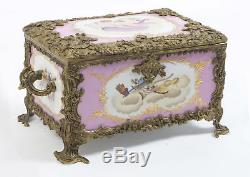Lovely Hand Painted Sevres Style Porcelain Casket Pink



Regent Antiques has been trading in London for three decades. We specialise in English and Continental antique furniture, silver and porcelain. Our main markets are Europe and North America and we export worldwide. Lovely Hand Painted Sevres Style Porcelain Casket Pink. This is a beautiful large French. Casket in a powder pink. From the last quarter of the. This highly decorative piece is hand painted with cherubs and musical instruments. It is further embellished with fabulous. It stands on lovely feet and has handles on the sides for easy of carrying. Relive the unparalleled grandeur and instill the refined elegance of a bygone era to a special place in your home with this fabulous. In excellent condition , p lease see photos for confirmation of condition.
Height 19 x Width 39 x Depth 25. Height 7.5 x Width 15.4 x Depth 9.8.
Sevres Porcelain traces its roots in France to early craftsmen who had small manufacturing operations in such places as Lille, Rouen. Cloud, and most notably Chantilly.
It is from Chantilly that a cadre of workers migrated to the Chateau de Vincennes near Paris to form a larger porcelain manufactory in 1738. French King Louis XV, perhaps inspired by his rumoured relationship with mistress Madame de Pompadour, took an intense interest in porcelain and moved the operation in 1756 to even larger quarters in the Paris suburb of Sevres. Sevres was also conveniently near the home of Madame de Pompadour and the King's own Palace at Versailles. From the outset the king's clear aim was to produce Sevres Porcelain that surpassed the established Saxony works of Meissen and Dresden. Though the French lacked an ample supply of kaolin, a required ingredient for hard-paste porcelain (pate dure), their soft-paste porcelain (pate tendre) was fired at a lower temperature and was thus compatible with a wider variety of colours and glazes that in many cases were also richer and more vivid. Unglazed white Sevres Porcelain "biscuit" figurines were also a great success. However, soft-paste Sevres Porcelain was more easily broken.Therefore, early pieces of Sevres Porcelain that remain intact have become rare indeed. The Sevres Porcelain manufactory always seemed to be in dire financial straits despite the incredibly fine works it produced. In fact, the king's insistence that only the finest items be created may have contributed to the difficulties.
Only a limited number of European nobility could afford the extravagant prices demanded for such works. King Louis XV and eventually his heir, the ill-fated Louis XVI, were obliged to invest heavily in the enterprise. Ultimately, the Sevres Porcelain Factory produced items under the name of "Royal" and thus the well-known Sevres mark was born. King Louis XV even mandated laws that severely restricted other porcelain production in France so as to retain a near monopoly for his Sevres Porcelain.
The king even willingly became chief salesman for the finest of his products, hosting an annual New Year's Day showing for French nobility in his private quarters at Versailles. He eagerly circulated among potential buyers, pitching the merits of ownership and policing the occasional light-fingered guest.
By 1800, the Sevres Porcelain Works were practically out of business due to the economic devastation of the new French Republic. About the time when Napoleon Bonaparte named himself Emperor of France (1804), a new director was named for the Sevres Porcelain Manufactory. Alexandre Brongniart, highly educated in many fields, resurrected Sevres Porcelain. Soft-paste porcelain was eliminated altogether thanks to the earlier discovery of kaolin near Limoges. For four decades until his death, Brongniart presided over monumental progress for Sevres Porcelain, catering not only to Napoleon himself, but at last to include the more financially profitable mid-priced market in the emerging middle class.
Ormolu (from French'or moulu', signifying ground or pounded gold) is an 18th-century English term for applying finely ground, high-carat. The mercury is driven off in a. Leaving behind a gold-coloured veneer known as'gilt bronze'. The manufacture of true ormolu employs a process known as mercury-gilding or fire-gilding.
In which a solution of nitrate of mercury. Is applied to a piece of copper. Or bronze, followed by the application of an amalgam.
The item was then exposed to extreme heat until the mercury burned off and the gold remained, adhered to the metal object. No true ormolu was produced in France after around 1830 because legislation had outlawed the use of mercury. Therefore, other techniques were used instead but nothing surpasses the original mercury-firing ormolu method for sheer beauty and richness of colour.
Is the most common modern technique. Ormolu techniques are essentially the same as those used on silver. Take a tour of our London showrooms. Take Piccadilly line to Manor House station. Go to top of escalators and turn left.
Take exit 7 and walk straight on for 10 metres. Manor Warehouse is on the right. There is car parking available on site. Please make all cheques payable to Regent Antiques. Bank details: Regent Antiques - BBVA - Account: 05701615 - Sort: 23-59-11. For the best value, we recommend offsetting this cost by purchasing multiple items. The item "Lovely Hand Painted Sevres Style Porcelain Casket Pink" is in sale since Friday, February 13, 2015.This item is in the category "Pottery, Porcelain & Glass\Porcelain/China\Other Porcelain/China". The seller is "regentantiquesuk" and is located in London N4 1BX. This item can be shipped worldwide.
- Brand: Does Not Apply
- MPN: Does Not Apply


